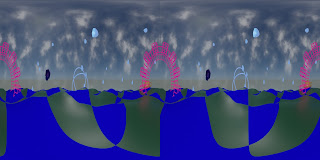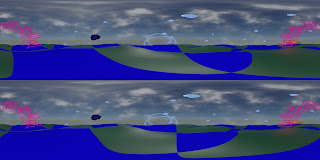Years ago I used Blender to make a stereographic test. It took forever to render a tiny, very low resolution test so I had to drop it at the time. (http://youtu.be/MWpsBb3enek if you want to see it.)
Now it is 2020 and I had some time last week. I couldn't find the blend file from my original example, so I made a new example, again using Blender.
Really should be viewed with VR goggles, and you'll need to tell YouTube to use a higher resolution setting, but the compression wasn't too kind. Even so, I'm encouraged to continue.
I'm still looking for a way to inject the needed metadata on Linux. I had to do this on a Windows machine because the injector is only for MacOS and Windows.
BTW, I had to render this twice because originally I rendered it side-by-side (SBS) but the YouTube Metadata Injector only accepts top-and-bottom (TAB).
Here's the same frame in each format:
 |
| 3D stereoscopic test frame, SBS. |








